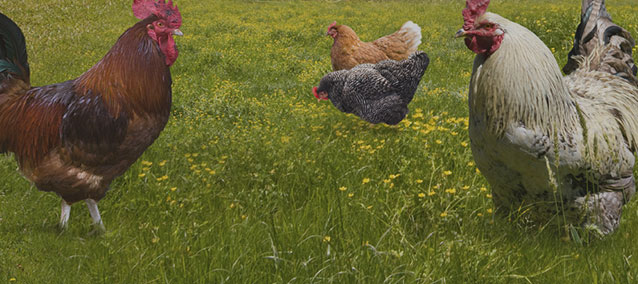Chickens Raised for Food are:
- housed in dark buildings the size of football fields, each holding 20-30,000 tightly-packed babies.
- forced to grow 3 1/2 times faster than is natural, so fast that their hearts and lungs cannot support the requirements of their body weight, resulting in congestive heart failure.
- raised in a toxic waste environment comprised of excretory ammonia fumes, viruses, fungi, bacteria, gram-negative endotoxins and other respiratory
poisons. - if genetically modified, debilitated with legs that cannot support their body weight, resulting in painful hip dislocations and an inability to walk.
- generally going to slaughter with respiratory infections, skin diseases and crippled joints.
- not receiving any individual care or veterinary treatment.
- violently hurled into transport crates headed for slaughter when only 45 days old.
- yanked out of the transport crates at slaughter plants, hung upside down on conveyer belts and dragged through cold, salted, electrified water designed to paralyze the muscles of their feather follicles to facilitate pulling out their feathers after they’re dead.
- not stunned prior to having their throats cut.
- intentionally kept alive during the slaughter process so their hearts will continue to pump blood.
Plus: Millions of chickens are scalded alive in huge tanks after neck-cutting, where they flop, scream, kick, break their bones, and their eyeballs pop out of their heads.
Hens Raised to Lay Eggs are:
- painfully debeaked at the hatchery, with no anesthesia.
- typically raised in 50 X 500 ft caged laying hen houses holding 80,000-125,000 hens (99 percent of U.S. laying hens are in cages averaging 8 hens per cage or about 48 to 61 square inches – a hen needs 72 square inches merely to stand comfortably and 290 square inches to flap her wings).
- force molted by food deprivation for up to 2 weeks to manipulate egg
production. - suffering from osteoporosis from lack of exercise and inadequate calcium for bone maintenance (hens would normally spend 60 percent of their day foraging for food).
- continuously breathing poisonous ammonia fumes arising from the manure pits beneath their cages.
- suffering from chronic respiratory diseases and untreated wounds and infections without veterinary care or treatment.
- prone to getting their heads and wings caught in the cage bars, resulting in a slow, painful death (the survivors live side by side with rotting corpses of their former cage mates and the only relief they get from standing on wires is standing on these corpses).
- when “spent,” generally put in dumpsters on site to suffocate (or are electrocuted or gassed) to death and then trucked to rendering companies to be turned into “pet” food, livestock/poultry feed and “spent hen” meal.
Plus: Yearly more than 250 million “egg-type” male chicks are suffocated, gassed or ground up alive at the hatchery because they don’t lay eggs and have no commercial value apart from pet food and farmed animal feed.
What About Free-Range Chickens?
Egg-laying hens:
- are debeaked at the hatchery in the same manner as battery-caged hens.
- may be force molted by food deprivation the same as battery-caged hens.
- often have only 1 to 2 square feet of living space per bird, typically living in crowded flocks of 2,000 or more birds (free-range does not solve the problem of oversized flocks and an unstimulating environment).
- are hauled to slaughter after a year or two, the same as battery-caged hens.
Plus: The male chick counterparts of free-range hens are destroyed at the hatchery using the same horrific methods as non-free-range chicks.
And: Although “free-range” chickens raised for meat must have USDA-certified access to the outdoors, environmental quality and space per bird are ignored in the regulations.
Did You Know?
In the United States, 9 billion chickens are slaughtered yearly for food, and worldwide it’s over 50 billion.
- 300 million laying hens are in U.S. agribusiness production each year.
- Chickens are excluded from the Animal Welfare and the Humane Methods of Slaughter Acts.
- The average American consumes 21 chickens per year, compared to approximately one (or part of one) cow or pig.
- Switching from “red meat” to chicken involves the suffering and slaughter of many more animals (it takes many small animals to add up to one large one).

